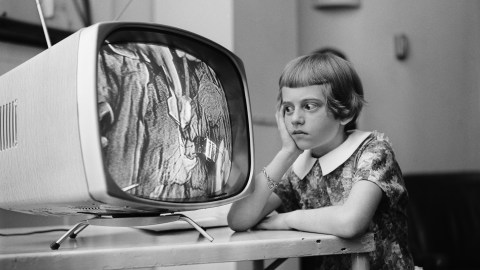An ancient technique can improve your attention span

- Attention is a scarce economic resource; you only have so much to give in your lifetime.
- Life’s modern distractions, such as news and social media, have overwhelmed our evolutionarily designed attention spans.
- According to neuroscientist Amishi Jha, 12 minutes of mindfulness training a day strengthens your attentional systems.
Does this sound familiar? You can’t focus. You’re bored one minute, overwhelmed the next, and stressed either way. You make mistakes you shouldn’t and then dwell on them for hours. When you try to be productive, you can’t go five minutes without checking your texts, dreading some future engagement, or walking into another room to check on … something. (What was it again?)
Neuroscientist Amishi Jha opens her book, Peak Mind, with this vignette to illustrate an important truth: You’re not alone. Most people can’t go three minutes at work without being interrupted by a chatty colleague, and students cite the allure of social media and other digital distractions as a major disruptor to their studies.
“I’ve seen certain universal patterns in the way all of our brains function — both how powerfully they can focus, and how extraordinarily vulnerable they are to distraction — no matter who you are or what you do,” Jha writes.
At the heart of this predicament, Jha argues, is attention — specifically, the many ways we can disconnect from it. Depleted attention creates a mental fog. Hijacked attention manifests as anxiety and worry. Fragmented attention shatters our ability to focus. Disconnected attention keeps us detached from others. Each attentional affliction causes you to grow out of sync with what’s happening around you, affecting what you think, how you feel, what you learn, how you react, and your relationships with others.
In short, attention isn’t just a matter of where your focus happens to be. It’s the internal force that shapes how you encounter and experience your life in its entirety.
Attention: A cognitive currency
In her book, Jha compares attention to a currency. You can pay it to others, and they can give theirs to you. You can request it in the spirit of charity — “Will you give me your attention, please?” And as any parent whose child is within earshot of an ice cream truck can attest, attention can be stolen outright.
This connection is more than metaphorical. Attention is a scarce economic resource; you only have so much to give in your lifetime. When you focus on a person, tweet, daydream, or TV show, you are spending a moment of attention. You can never get it back, and you can’t provide it elsewhere. The same is true for any $10 bill that’s left your wallet.
But like that ten-spot, attention is also a means of exchange. In exchange for yours, you may receive love, knowledge, entertainment, self-understanding, and much more.
“Given how powerful attention is, we need to really respect where we place this precious brain resource,” Jha said in an interview.
Evolutionary life insurance
This cognitive currency is traded through your brain’s attention system. This system filters out unnecessary noises, sights, and sounds from the environment alongside distracting thoughts and mental chatter. Without it, you couldn’t focus at all. Your conscious mind would stall from the vast amounts of information bombarding it — like a computer with overloaded RAM.
This attention system isn’t foolproof, though. It becomes easily distracted when it encounters novel, exciting, threatening, or self-related information in the environment. And this backdoor hack isn’t a flaw; it’s a feature of evolutionary design.
For example, imagine you’re an ancient human who is spearfishing in an African river. You’re focused intently on the glittering water, trying to aim your thrust to account for the bending light. Suddenly, your eye catches something in its periphery. It’s long, brown, and moving half-submerged through the water.
Your attention system will break its focus and snap toward that potential threat. If it’s a log, you’ve paid a pittance of attention and can return to fishing. But if it’s a Nile crocodile, then your attentional insurance paid out big. Distraction just saved your life.

Living in the attentional red
While distraction has its uses, today it’s an ever-present quality of our lives, wrenching us from our attention when we need it most. That’s because, Jha writes, while attention is powerful, it’s also fragile. It can be easily broken by stress, threats, and negative moods. And the prevalence of these forces is causing our crisis of attention.
Don’t get the wrong idea. Much like distraction, these three forces can be advantageous. Stress has a positive side called eustress. It’s the low-to-medium levels of stress that motivate you to accomplish something. Without it, you’d have no drive, and every day would be a listless lull in the doldrums.
Similarly, a negative mood can signal that something is wrong. That unease can propel you to solve the problem and lift the emotional pall.
But the modern world has hyper-charged these forces beyond the tipping point of usefulness. Stress has become distress, negative moods have become chronic melancholy, and threats are overrepresented. There are many reasons for this hyper-charging, but a prominent one is the attention economy.
Technology companies, news media, and political players now recognize attention as the resource it is and, in some ways, regard it as more valuable than money. “[M]oney follows attention, whereas the reverse is not necessarily true. As our economy becomes more dependent on attention, the medium of exchange flows from the holders of the old to the holders of the new,” writes the Berkeley Economic Review.
Given attention’s value, it’s little wonder enterprises have built products and services to target the attentional back doors left open by evolution.
News organizations, for example, favor headlines that drip with threat and tragedy — the so-called “if it bleeds, it leads” standard. That’s because we’re hardwired to assess threats and determine what can be done. Essentially, we need to find out if the story represents a log or a crocodile. The more people compelled to perform that assessment, the more newspapers sold.
These threats don’t have to be physical. As Jha writes, “Our reputation, financial well-being, or sense of justice can all be under threat.”
People used to pay some of their daily attention to the news, either a morning read of the paper or an hour watching the evening broadcast. But in the era of 24/7 news coverage — the era of the attention economy — we’re paying that attentional cost throughout the day. Over time, it becomes a sizable withdraw of our mental energy, yet we continue to check our news feeds for threats even when we should be focused on something else.
Without devoting attention, we don’t experience care, and we can’t extend care. In fact, you might say that paying attention to another person is our highest form of love.
~ Amishi Jha
Train your attention
Is the answer then to wall yourself off from stressors, disconnect from social media, and choose not to engage with news coverage?
“My answer is a resounding no,” Jha writes. “Many stressors are unavoidable, while others are part of our journey to fulfillment and success — if we remove them, we would be limiting ourselves.”
While attention is both powerful and fragile, it has a third feature: It’s trainable through mindfulness. Just as exercise trains the body, mindfulness trains the mind by strengthening your meta-awareness — that is, your ability to be aware of where you’re placing your awareness.
The stronger your meta-awareness becomes, the more control you have over your attention system. That control then helps you keep your attention on the present moment, enriching how you encounter and experience your life.
Through her research, Jha discovered what she calls the “minimum effective dose” of mindfulness. Her team found that lab participants who practiced mindfulness for 12 minutes or more a day saw benefits in objective measures of attention and mood. Those who practiced for less did not.
In Peak Mind, Jha lays out a four-week regimen to help readers build their mindfulness habits. But in her interview, Jha shared an exercise you can do right now to exercise your attentional system. Simply follow these steps:
- Start by settling into your body.
- Notice yourself sitting and breathing.
- If you feel comfortable, close your eyes.
- Ask: What’s most vividly tied to my breath? Is it the coolness of air moving in and out of my nostrils? Or are my shoulders moving up and down?
- Direct your focus on this sensation.
- If you notice your attention has wandered, redirect it back to your breath.
On the page, the exercise seems painfully easy. Maybe even a little boring. But you’ll likely find your mind often drifts away from the sensation of your breathing. You’ll become lost in reliving a childhood memory, worrying over an unfinished project, or delighting in a favorite fantasy. Whatever the case, it’s not a failure on your part. Redirecting your focus back to the breath is the whole point. That’s the key to strengthening your attention span.
“Minds wander. It’s a natural thing that the brain does. When our mind moves away, gently return it back. Simply begin again,” Jha reminds you.
Learn more on Big Think+
With a diverse library of lessons from the world’s biggest thinkers, Big Think+ helps businesses get smarter, faster. To access Amishi Jha’s full class for your organization, request a demo.





